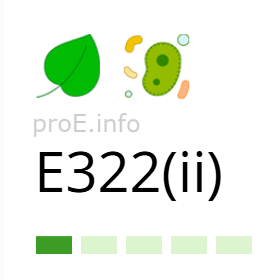
Other names for the additive (synonyms)
General Information
The food additive E322(ii) refers to partially hydrolyzed lecithin, a subtype of E322 obtained through enzymatic hydrolysis of natural phospholipids. During hydrolysis, the content of lysophospholipids increases, giving the additive specific functional properties.
In the food industry, emulsifier E322ii is produced in two forms:
- Hydrolyzed liquid lecithin — a homogeneous viscous liquid ranging from light yellow to dark brown, containing at least 56% acetone-insoluble matter, as well as approximately 44% triacylglycerols, free fatty acids, and accompanying components.
- Hydrolyzed defatted lecithin — a powder or granules of similar color, containing at least 95% acetone-insoluble matter, with a high content of lysophospholipids and minimal fat content.
Phospholipid hydrolysis is a chemical process in which lecithin molecules are exposed to specific enzymes (most often phospholipases). These enzymes break the bonds between the glycerol backbone and the fatty acids that make up phospholipids. As a result, lysophospholipids are formed—compounds with one fatty acid instead of two—which interact better with water. This modification alters the functional properties of lecithin, particularly enhancing its emulsifying ability.
Thanks to its emulsifying and dispersing properties, emulsifier E322ii is used in formulations that require high emulsion stability, improved water solubility, and low fat content. It is commonly used in the production of beverages, confectionery, baby food, and dietary products.
Compared to E322(i) (natural lecithin), hydrolyzed lecithin is a more technologically processed form, which expands its functionality but may limit its use in organic products.
For more details on its properties, health effects, and legal status, refer to the general description of additive E322.